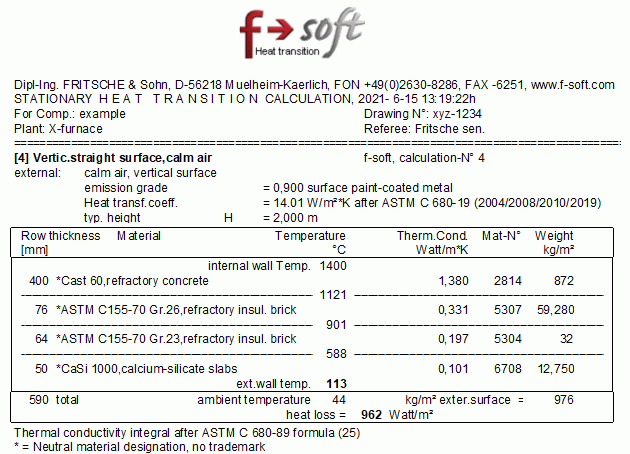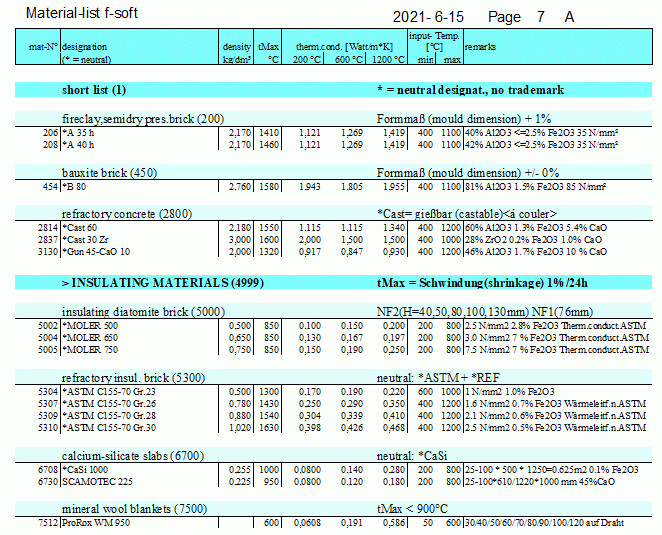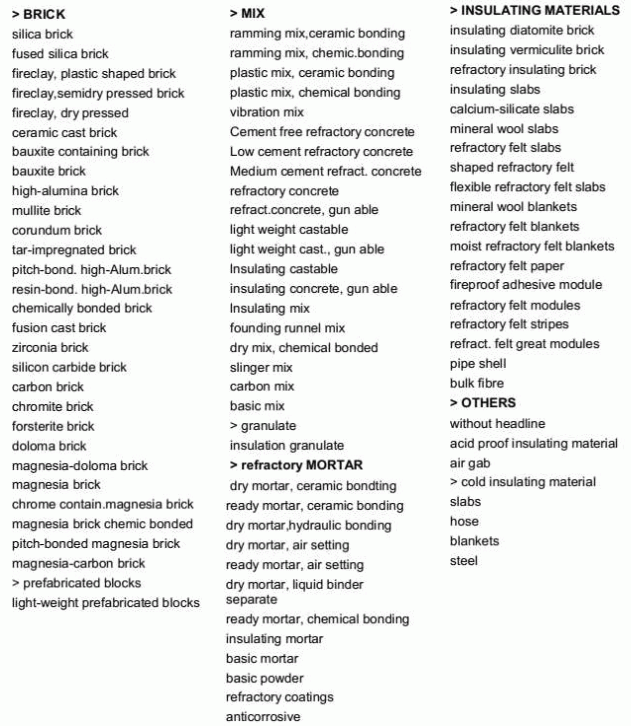
Basic program Heat Transition „WDurch6“
For industrial furnaces or freezing techniques,
not suitable for the construction of buildings and central heating.
Stationary = after an "infinitely" long equal heating.
PC-program, operating systems MS-WINDOWS 11, 10, 8 or 7 or 32/64 bit
No schooling, extern software or special hardware requirements are necessary.
The purpose of the Heat transition program is to calculate the heat loss of a kiln wall or of a heat insulation
and to find the curve of temperature through the wall of a kiln like shown below,
which leads to an optimal construction of different wall rows.
1. Result as diagram
If you are in the Homepage and you make a cutting out of the furnace layout, where only the right wall is shown,
you get the following diagram.
The X-axis shows the wall thickness and the Y-axis the temperature:

Figure 1: Course of temperature through a furnace wall
The furnace wall consists of different rows. The left row at the fire is cast of heavy refractory concrete 400 mm
*Cast 60 (* = neutral to trademarks), which can resist the attack of the flame and the high temperature of 400 °C.
The right row consists of light insulating slabs with the main component calcium-silicate,
shorted marked as 50 mm *CaSi 1000. 1000 means that it stands only up to 1000 °C,
this row could not resist the internal temperature of 1400 °C.
Between them there are placed two rows of refractory insulating brick for different steps of temperature.
Summarized: the (left) inner row shall resist the fire and the (right) outer rows shall cause the insulation.
2. Output of the calculation as table
In the following table 1 you see above (under ===) the dates for the heat transfer
between the furnace wall and the ambient air.

Table 1: Stationary heat transition calculation
In the middle part of the above table you find the dates from figure 1 and on the right side already further dates.
Out of 7 choices is shown the thermal conductivity of the single rows and their weight.
Under the calculation can be put an appertaining material table:

Table 2: Material table for the calculation
3. Output of the material file
According pos. 3 of the price list you can order a file „WLong“
of more than 1600 fireproof and insulating materials.
360 materials are given names neutral to trademarks, like the most heavy materials,
e.g. “*B 80, bauxite brick” (* = neutral).
Insulating materials are input mostly with trademarks.
From the gratis short file "WLDemo" with 30 materials is shown the following section:

Table 3: Material list "WLDemo"
For the fireclay brick (above) the short designations following the "Stahl-Eisen-Blatt 910-64"
of the "Verein Deutscher Eisenhüttenleute" (Union of German Steel makers) are used.
*A35 means, that the brick contains min. 35% Al2O3 (alumna oxide).
Refractory concrete (middle) is usually designed by first name *CAST or *GUN.
At the light diatomite brick (below INSULATING MATERIALS) the designation *MOLER 500 means,
that the brick has a density of about 500 kg/m3 = 0.5 kg/dm3 (column 3).
At the refractory insulation brick following the US-standard ASTM means Gr.23 (group 23),
that the brick is classified to 2300 ° Fahrenheit (1260°C).
The calcium-silicate slabs "Casi 1000" (below) should be stable up to 1000 ° C.
The user can at first make a calculation with these designations which are * = neutral to trademarks.
Then the suppliers can be selected following commercial points of view.
Later material names can be overwritten or materials with trade marks can be inserted in exchange.
The big material list "WLong" is divided by more than 90 multi-lingual headlines,
which are also appended to the material designation, in the calculation table 1 .
The following list of headlines is subdivided by 5 main headlines (bold):

Table 4: Headline list
4. Technical Overview in particular Words
As the program is organized "self guiding", an intuitive using is possible.
By this the program is fit for calculations with a portable computer at a customer.
Special functions:
Surface: Straight wall, dome, armature, cylinder (also internal cooled).
Temperature depending Thermal conductivity coefficient, also in H2 containing atmosphere,
is shown as parabola in a diagram, it can be extrapolated
and can be inserted into the calculation integral or at middle temperature.
To the Thermal conductivity can be inserted a factor and an addition for heat bridges like anchors.
Heat Transfer external following ASTM C680-19 (2004-2019), ASTM C680-89, EN ISO 12241, VDI 2055
for wind, sun radiation, constant dates, calm air at roof, bottom or vertical surface.
Heat Transfer in vacuum (only radiation).
Heat Transfer internal (hot side) calculated from inner measurements,
emission grade inside, convection, gas radiation of H2O, CO2, CH4.
Comfortable handling:
Numerous info and protections against handling errors.
Selection of the material list from the headline list (wih main headlines) at the screen following
Material-Nº, first name (trademark), main design (e.g. Al2O3%)
Density, limit temp. "tMax", thermal conductivity at 400°C.
A network license can be switched in this way,
that only one workstation has the right to edit in a central material file,
further users can only read the materials at the same time.
Variants can be easily changed and stored.
Output:
Calculation with your logo on screen, printer or a file,
with weight, heat-loss/m2 and per m cylinder
and heat transition, estimated price, Heat Capacity in Watt/Joule/kcal/BThU.
Dilatation (at a cylinder in 3 directions), dew point for freezing techniques.
Formulas for Heat Transition: Radiation and convection extern and intern
can be printed and recalculated.
Diagram in color for 20 rows max, writing vertical or horizontal.
Under the calculation can be put an appertaining material table
and a text for the limitation of guarantee.
Further descriptions you get in the program by the Help with F1 in English and German.
The price of the program can be profitable soon,
because the liquidation of a better insulation will be shown by the Help,
in the chapter: "Projects / Calculations / Comparison Heat-saving"
The DEMO-version contains an extension, which is briefly described in the price-list piont 4.
Detailed descrptions of this extension you find by the "Help",
Chapter:"Projects / Calculations / Temperature loss in conduction" and ".../Temperature loss in a vessel".
By the Help you find also a list of suppliers for fireproof and insulation material
in the chapter "Introduction / Supplier list".
Date: 09/2025
|



